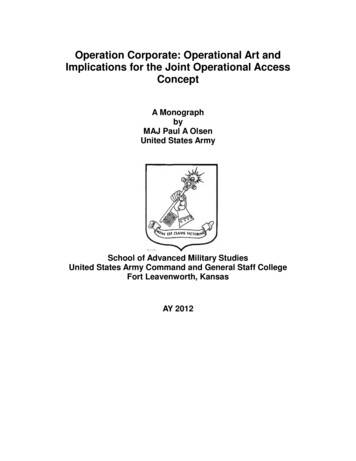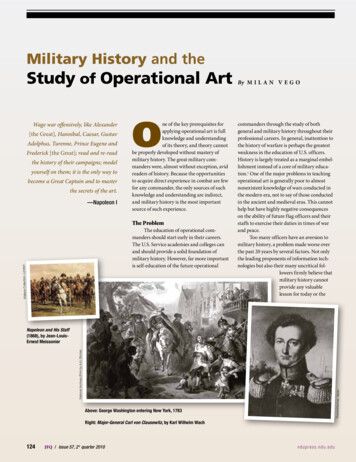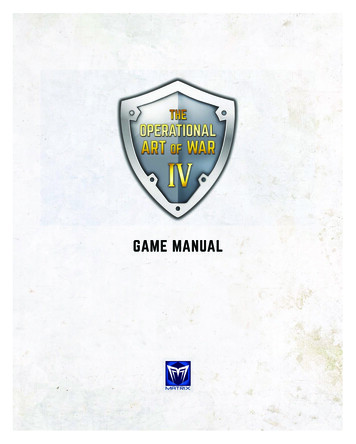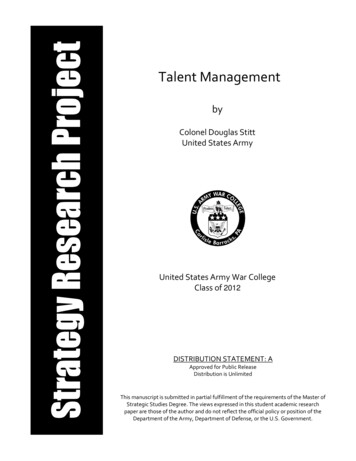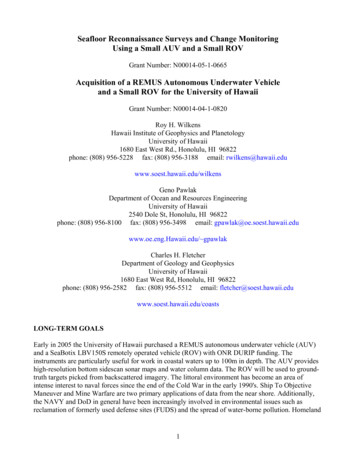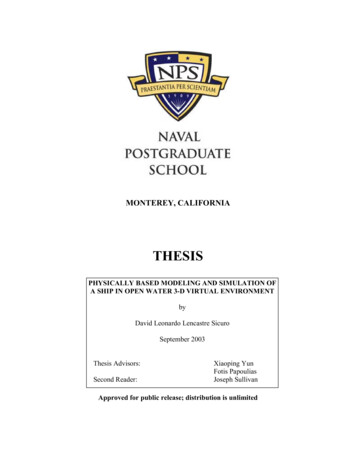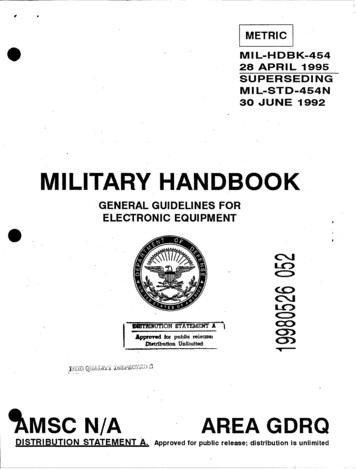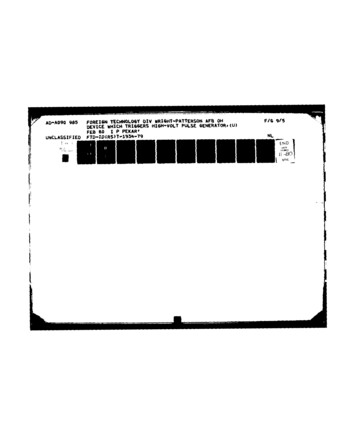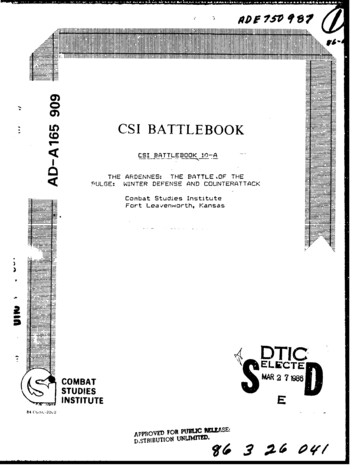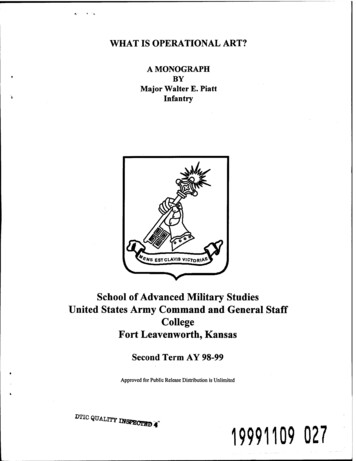
Transcription
WHAT IS OPERATIONAL ART?A MONOGRAPHBYMajor Walter E. PiattInfantryi «S ESTCLAVIS VlCTQR\P&ySchool of Advanced Military StudiesUnited States Army Command and General StaffCollegeFort Leavenworth, KansasSecond Term AY 98-99Approved for Public Release Distribution is UnlimitedDTIC QUALITY apsoiBD;19991109 027
r' " -*-Form ApprovedOMB No. 0704-0188REPORT DOCUMENTATION PAGE0»vtt Highwty. Suite 1204.Artlrvgton.VA 22202-O02. *nd to th«Offke of Management »nd ludget. Peperwork Reduction Project (07O4-O1M), Washington. OC 20M3.1. AGENCY USE ONLY (Leave blank)2. REPORT DATE3. REPORT TYPE AND DATES COVERED 7/ / 99MONOGRAPH4. TITLE AND SUBTITLE5. FUNDING NUMBERSj////ir xs oP *#T'o*J/iLd/?r?6. AUTHOR(S)7. PERFORMING ORGANIZATION NAME(S) AND ADDRESS(ES)PERFORMING ORGANIZATIONREPORT NUMBERSchool of Advanced Military StudiesCommand and General Staff- CollegeFort Leavenworth, Kansas 66027*. SPONSORING/MONITORING AGENCY NAME(S) AND ADDRESS(ES)10. SPONSORING/MONITORINGAGENCY REPORT NUMBERCommand and General Staff CollegeFort Leavenworth, Kansas 6602711. SUPPLEMENTARY NOTES12«. DISTRIBUTION/AVAILABILITY STATEMENT12b. DISTRIBUTION CODEAPPROVED FOR PUBLIC 8ELEASE:DISTRIBUTION UNLIMITED. .13. ABSTRACT (Maximum 200 words)14. SUBJECT TERMS15. NUMBER OF PAGESSS'Opera f/onaf /Nr T16. PRICE CODE17. SECURITY CLASSIFICATIONOF REPORTUNCLASSIFIEDNSN 7540-01-280-550018. SECURITY CLASSIFICATION19. SECURITY CLASSIFICATIONOF THIS PAGEOF ABSTRACTUNCLASSIFIEDUNCLASSIFIED20. LIMITATION OF ABSTRACTUNLIMITEDStandard Form 298 (Rev 2-89)
ABSTRACTWHAT IS OPERATIONAL ART? by MAJ Walter E. Piatt, USA, 49 pages.As the Army prepares the new FM 100-5 this monograph analyzes chapter two ofthe current draft, the theory of operational art. The latest draft FM 100-5 has failed tocreate a common understanding, and therefore cannot serve as doctrine. There are severalreasons for this. First, the draft doctrine does not capture successfully the timelesselements of operational art. Second, by not identifying the timeless elements, the humandimension of applying operational art is not emphasized to the degree necessary. Third,any doctrine explaining operational art must focus on applying the concepts to the presentday operations that the Army is being tasked to plan and conduct. Finally, regardless ofthe impact technology will have on the Army, the methodology for creative conduct ofmilitary operations must never be forgotten. Operational art will always drive tacticalactions. The focus of doctrine must be on how to apply operational art to practicalactivities. The concepts must transcend immediate technological conditions lest they beinvalidated by rapidly changing capabilities during the life of the manual.The purpose of this monograph is to rewrite the theory of operational art in a waythat can be understood by those who need to apply it in today's Army. This monographattempts to offer the editors and authors of the new FM 100-5 a simple and clearexplanation of operational art. This monograph answers the question what is operationalart by analyzing what operational art is in theory and in doctrine. This monograph thendistills the essential elements of operational art from the conceptual and practicalexplanations of operational art. Finally this monograph answers the question how doArmy forces execute operational art?These three questions answer the research question by determining a doctrinaldefinition for operational art, then distilling the theory of operational art in order to filterout the basic principles and essential elements, and finally, framing these principles andfundamentals into a definitive yet adaptable explanation of application.ui
SCHOOL OF ADVANCED MILITARY STUDIESMONOGRAPH APPROVALMajor Walter E. PiattTitle of Monograph: What is Operational Art?Approved by:hfM-WRobert M. Epstein, Ph.D.Monograph DirectorLTC Robin P. Swan, MMASDirector, School of AdvancedMilitary Studies\J. {dYVöue i—Philip J. Brookes, Ph.D.Director, Graduate DegreeProgramAccepted this 27th Day of May 1999
ABSTRACTWHAT IS OPERATIONAL ART? by MAT Walter E. Piatt, USA, 49 pages.As the Army prepares the new FM 100-5 this monograph analyzes chapter two ofthe current draft, the theory of operational art. The latest draft FM 100-5 has failed tocreate a common understanding, and therefore cannot serve as doctrine. There are severalreasons for this. First, the draft doctrine does not capture successfully the timelesselements of operational art. Second, by not identifying the timeless elements, the humandimension of applying operational art is not emphasized to the degree necessary. Third,any doctrine explaining operational art must focus on applying the concepts to the presentday operations that the Army is being tasked to plan and conduct. Finally, regardless ofthe impact technology will have on the Army, the methodology for creative conduct ofmilitary operations must never be forgotten. Operational art will always drive tacticalactions. The focus of doctrine must be on how to apply operational art to practicalactivities. The concepts must transcend immediate technological conditions lest they beinvalidated by rapidly changing capabilities during the life of the manual.The purpose of this monograph is to rewrite the theory of operational art in a waythat can be understood by those who need to apply it in today's Army. This monographattempts to offer the editors and authors of the new FM 100-5 a simple and clearexplanation of operational art. This monograph answers the question what is operationalart by analyzing what operational art is in theory and in doctrine. This monograph thendistills the essential elements of operational art from the conceptual and practicalexplanations of operational art. Finally this monograph answers the question how doArmy forces execute operational art?These three questions answer the research question by determining a doctrinaldefinition for operational art, then distilling the theory of operational art in order to filterout the basic principles and essential elements, and finally, framing these principles andfundamentals into a definitive yet adaptable explanation of application.in
TABLE OF CONTENTSPageSectionI. IntroductionII. Origin and Evolution of Operational ArtNapoleon and the Origin of Modern WarfareThe US Civil War and the Birth of Modern WarfareThe Evolution of Operational TheoryThe Doctrinal Evolution of Operational Art 57101416m. The Essential Elements of Operational Art22IV. Framework for ApplicationOperational Art29-"V. Conclusion 46EndnotesBibliography IV4y
I. IntroductionAs the Army prepares for the twenty-first century it continues to struggle with thedevelopment of the new FM 100-5. The current draft of the new FM 100-5 attempts todefine the theory of operational art in the second chapter. The chapter is entitled "TheTheory of Operational Art" and is almost sixty pages in length. This lengthy explanationof the theory of operational art has caused confusion in the field, leading many seniorcommanders to reject the draft FM 100-5 and call for clarification from the authors of themanual.The main problem with the new FM 100-5 is chapter two. It has stirred strongemotional responses by senior leaders in the field. Many in the Army view that the reasonfor such strong opposition is the abstract character of chapter two, the theory ofoperational art. The chapter is too long and too contusing to be understood by the targetaudience. The writers of FM 100-5 did not produce the draft manual for the purpose tocreate confusion. The Army recognizes the necessity to understand operational art andthe draft manual was intended to explain it. Unfortunately it missed the target.After the 1982 version of FM 100-5, the Army began to think seriously about whatoperational art is and how it should be applied to the conduct of operations. The 1986manual reflected a good bit ofthat thought and produced a generation of Army officerswho understood operational art better than the generation that preceded them. The Armycontinued to evolve and the strategic view of the world changed. By the late 1980's newtheories on operational art began to emerge. The latest draft of FM 100-5 is an attempt to
place the new theories on operational art into doctrine. The problem is that the newmanual does not read like doctrine. To be successful doctrine must be understood andmust be followed. The draft FM100-5 has not created a common understanding, andtherefore cannot serve as doctrine. There are several reasons for this. First, the draftdoctrine does not capture successfully the timeless elements of operational art. Second,by not identifying the timeless elements, the human dimension of applying operational art,which is perhaps the most important element, is not emphasized to the degree necessary.Third, any doctrine explaining operational art must focus on applying the concepts to thepresent day operations that the Army is being tasked to plan and conduct. Finally,regardless of the impact technology will have on the Army, the methodology for creativeconduct of military operations must never be forgotten. Operational art will always drivetactical actions. The focus of doctrine must be on how to apply operational art topractical activities. The concepts must transcend immediate technological conditions lestthey be invalidated by rapidly changing capabilities during the life of the manual.Military doctrine must gain its backbone from military theory and history but itmust be more. Doctrine must produce a shared understanding on how to apply basicprinciples and fundamentals derived from theory and history. Military doctrine is thepractical application of the basic fundamentals derived from theoretical work. Doctrine isnot simply a regurgitation of theory. Doctrine must be capable of being applied in the realworld by real people, when real lives are at stake.The mission of this monograph is to rewrite the theory of operational art in a waythat can be understood by those who need to apply it in today's Army. This monograph
attempts to offer the editors and authors of the new FM 100-5 a simple and clearexplanation of operational art. To do this several questions must be answered. The firstquestion is, what is operational art? In order to answer this question several questionsmust be answered. They are: a. What is operational art? In theory; what is theconceptual explanation? In practice; what is the practical explanation? b. What are theessential elements of operational art? and c. How do Army forces execute operationalart? This monograph answers these questions in three separate sections. The conceptualand practical explanation for operational art is answered first. Second, the essentialelements of operational art are identified, and thirdly a framework for the application ofoperational art is constructed.These three questions answer the research question by determining a doctrinaldefinition for operational art, then distilling the theory of operational art in order to filterout the basic principles and essential elements, and finally, framing these principles andfundamentals into a definitive yet adaptable explanation of application.To be successful this monograph must offer a framework for the application ofoperational art suitable for doctrine. The following evaluation criteria were used:a. Simple. Defined as easily understood by field grade officers and above.b. Definitive. Provides a common understanding of what operational art is.c. Adaptive. Is not seen as a "cookie cutter" solution nor as a "check list", canbe applied to all types of military operations and different situations.d. Descriptive. Clearly describes the application, not a regurgitation of thetheory. Can be applied to the realities of warfare today.e. Prescriptive. Can stand alone as a start point for campaign planning.
It is all too easy to stand on the sidelines and criticize those playing the game. Thismonograph is not an attempt to poke holes in the current draft. Instead, this monograph isan attempt to offer a solution, not just to become part of the problem In the end thismonograph may fall victim to the same criticism that plagues the draft FM100-5. Thequest for common understanding in a complex world, is at best difficult, but the Armymust continue towards this goal if it is going to be successful in the twenty-first century.The first step towards understanding a complex theory is to understand the origin andevolution of it. Understanding the past is the key to truly understanding the lessons thatought to be learned and applied to present and future military operations.
II. Origin and Evolution of Operational ArtThere is as much controversy amongst military historians surrounding the origin ofoperational art as there is surrounding the origin and evolution of humankind. In order tounderstand what operational art is and how it should be applied to present day militaryoperations it is first necessary to understand how operational art originated and how itevolved. This section answers the question what is operational art, by looking first at it'sorigins in theory and evolution in modern doctrine.Operational art is defined today in joint doctrine as: The employment of militaryforces to attain strategic and/or operational objectives through the design, organization,integration, and conduct of campaigns, major operations, and battles. Operational arttranslates the joint force commander's strategy into operational design, and, ultimatelytactical action, by integrating the key activities at all levels of war.lThe Army definition found in the 1993 version of FM 100-5 is: The employmentof military forces to attain strategic goals through the design, organization, integration,and execution of battles and engagements into campaigns and major operations. In war,operational art determines when, where, and for what purpose major forces will fight overtime.2The joint and army doctrinal definitions are not really that different, theirsimilarities offer some clues to understanding the origin of operational art. Bothdefinitions clearly state that operational art is the link between strategic aim and tacticalaction. The idea that war should be directly linked to the aims of the nation state is
nothing new. Sun Tzu wrote "Warfare is the greatest affair of the state, the basis of lifeand death, the way to survival or extinction. It must be thoroughly pondered andanalyzed."3What is clearly different now then when Sun Tzu wrote about war is the method inwhich war is executed. Warfare has become much more complex as it evolved over time.The origin of operational art is a product of the evolution of warfare and can be traced tothe birth of modern warfare. This can be seen in the other similarity between the joint andArmy definitions of operational art. Both definitions use plurals when describing battles,campaigns, operations, and objectives. Understanding why these words are plural and notsingular is the required first step toward understanding operational art. These pluralscreated the gap between strategy and tactics that is Called the operational level of war.The when and the how operational art originated is a subject still being debated.Two different schools of thought on the origin of modern warfare provide some basicclues to the origin of operational art. Two separate views of the origin of modern warfareare held by two senior faculty members at the School of Advanced Military Studies at FortLeavenworth, Kansas. The School of Advanced Military Studies, or SAMS, is the Army'sschool for teaching Army officers how to plan for and conduct military operations at theoperational level of war. The two theories are both extremely interesting, but moreimportantly shed light on the core elements of operational art. The first theory argues thatmodern warfare began with Napoleon, the second theory claims the US Civil War as theorigin. Both theories present valid arguments and both must be reviewed in order tounderstand operational art.
Napoleon and the Origin of Modern WarfareRobert M. Epstein, a professor of history at the School of Advanced MilitaryStudies, presents his theory in his book entitled, Napoleon's Last Victory: 1809 and theEmergence of Modern War. Professor Epstein argues that there are more factors toconsider, than simply technological factors, when determining the origin of modern war.The factors that Epstein considers are, structural, organizational, intellectual, andoperational elements.Epstein defines modern war when it has the following characteristics: a strategicwar plan that effectively integrates the various theaters of operations, the fullestmobilization of the resources of the state, and the use of operational campaigns byopposing sides to achieve strategic objectives in the various theaters of operations.Epstein's characterization of operational campaigns further explains his theory. Epsteindescribes operational campaigns in the following quote taken from his book."Those operational campaigns are characterized by symmetrical conscript armiesorganized into corps, maneuvered in a distributed fashion so that tactical engagements aresequenced and often simultaneous, command is decentralized, yet the commanders have acommon understanding of operational methods. Victory is achieved by the cumulativeeffects of tactical engagements and operational campaigns."5Epstein argues that by using his criteria then perhaps modern warfare began withNapoleonic France and Hapsburg Austria in 1809.6 It is difficult to argue that Eptein'selements that make up modern war are not valid. Look at the last sentence in the abovequote, where Epstein sates that victory is achieved by the cumulative effects of tactical
engagements and operational campaigns. This concept is still seen in the doctrinaldefinition of operational art today. It sheds light on why the words battle, engagement,and operation are written as plurals in the present day definitions of operational art.Victory in modern war requires more than one battle, engagement, campaign, or majoroperation. This need for more than one battle, which evolved as a by product of factorsthat Epstein discusses, created an area between strategy and tactics that is now called theoperational level of war. Epstein defines operational art as the process of action andthought performed at the operational level of war.7At first glance Epstein's theory may seem contradictory to what is most commonlybelieved about Napoleonic warfare. Most Army officers have studied only the surface ofNapoleon and his contribution to the evolution of warfere. There are manymisperceptions that surround Napoleon, one of which is that Napoleon commanded hisentire army through centralized control. Epstein claims that through the creation of armycorps and division and corps staff, that Napoleon executed decentralized control.8Napoleon's structural changes to the army allowed him the means to force theenemy into battle. To do this successfully Napoleon was forced to create a link betweencampaign maneuver and battles. It was the creation of this link, argues Epstein, that theoperational level of war was born.9Napoleon's intellectual approach to war was also revolutionary and contributedgreatly to the origin of operational art. Epstein's theory claims that Napoleon learned thisapproach through the study of Pierre Bourcet. Bourcet predicted that the intellectualapproach to campaign planning would have to adapt to accommodate the new structure
and method of the larger armies being formed.10 Napoleon was the right man to bring thisidea to fruition. Napoleon possessed the ability to see the hole picture. Napoleon plannedhis campaigns based on what would later be called operational vision. Napoleonunderstood that through distributed maneuver of his army he could fight his enemiesdivided.11Through the sheer size of Napoleon's army and the use of distributed maneuver itwould require more than one battle to destroy his army. Distributed maneuver also forcedNapoleon to plan for several engagements in a single campaign. This concept of morethan one battle to decide a war is essential to understanding operational art today. Otherkey elements of operational art to be drawn from Epstein's theory are, intellectualapproach or the human element, distributed maneuver, structural and organizationalchanges, command and control, holistic approach or operational vision, and campaigndesign that includes branches.All the lessons of Napoleon may not have been fully embraced by historians andtheorists. The wrong lesson may have been learned by the great military leaders thatfollowed. This wrong lesson, or misconception of Napoleon, is that a war could bedecided by a single battle. This misconception created a singular vision towards militaryoperations and would influence military instruction in the nineteenth century. Thissingular vision, or desire to end the war with a single decisive battle, may still linger in theminds of present day officers and hinder understanding of operational art. Epstein provesthat this is clearly the wrong lesson to derive from the study of Napoleon. It may havebeen this wrong lesson though, that planted the desire for many leaders to emulate
Napoleon. After Napoleon military leaders desired to obtain the one quick decisive battleto end the war. It was not to be. It would take another genius a half a century later tofigure it out, his name was Ulysses S. Grant.The US Civil War and the Birth of Modern WarfareThe second theory of the origin of modern war and operational art is presented byanother senior faculty member at SAMS. James J. Schneider presents his theory of theorigin of operational art in two papers, the first, Theoretical Paper No. 3, and the second,Theoretical Paper No. 4.12 Schneider's theory states that one of the chief causes of theorigin of operational art was the industrial revolution. The theory simply stated goes asfollows.As population increased due to the industrial revolution armies began to grow insize. Larger armies were needed to protect the resources of the state or to acquire moreresources outside the state. Technology also increased due to the industrial revolution,this led to increased lethality of the larger armies. The increase in lethality led todispersion of the armies on the battlefield. This dispersion on the battlefield meant that noone army could engage the entire army of the opponent at the same time. Smallersegments of each army opposed each other across the dispersed battlefield. This meantthat engagements were no longer totally decisive within themselves, meaning that a singlebattle would not lead to the total surrender of the opponent. An army could no longer bedestroyed with a single tactical engagement. This meant that a war between two nationstates could no longer be decided with a single battle.13 A closer look at some key pointsis required to understand this theory a little better.10
Schneider defines operational art as the employment of military forces to attainstrategic goals through design, organization and execution of campaigns and majoroperations.14 Schneider claims that operational art is characterized by the employment offorces in deep distributed operations. According to Schneider operational art is a uniquestyle of military art. Operational art, Schneider claims, became the planning, executionand sustainment of temporally and spatially distributed maneuvers and battles, all beingviewed as an organic whole.Schneider's theory classifies Napoleonic war as classical strategy, he comparesseven factors that depict the difference between classical strategy and operational art.They are listed in table 2-1.Classical StrategyOperational Art1. Battles and engagements beginimmediately at the national border.2.Several armies fight indecisive2. Armies collide in decisive battles.battles.3. The only decisive battle is the last initial3. Logistics is a consideration only inBattle of the warphases of the campaign.4. Logistics considerations impose pauses4. Vigorous pursuit after battle.upon operations often before pursuit can bedecisive.5. Wars consist of several campaigns;5. Campaign ends.campaigns consist of several distinct battlesand maneuvers.6. Operational art is strategy with the added6. Generally war is also terminated.dimension of depth.7. The commander sees very little of the7. The commander sees the entiremany simultaneous battles occurring.battlefield.16Table 2-1; Schneider's Comparison of Classical Strategy to Operational Art1. Maneuver to Contact11
Schneider uses Grant's Virginia Campaign of 1864 to illustrate the differencebetween classical strategy and operational art. Grant's orchestration of simultaneousoperations of more than one army to achieve a grand strategy is the birth of operational artaccording to Schneider.17 The theory goes deeper than just the origin of operational art,Schneider illustrates the impact this new concept made on planning and executing militaryoperations. The theory highlights some very important factors that must be consideredwhen planning at the operational level. Operational art must carefully analyze the ends,means, ways, and risks for a military operation. "Operational art is the process by whichthe methods are selected that determine the application and utilization of combat power—the means—to achieve a desired end."18 The essential elements of operational art r of Gravity.Decisive and Objective points.The Central position and Line of Operations.Theaters of Interest19These key elements taken from Schneider's theory offer some insight to whatmight still be relevant to the military commander today. Another key element thatSchneider uses to describe operational art is the added dimension of depth. Depth is notonly meant to be linear or geographical, but also depth in relation to the effects on theenemy. These effects in depth affect not only the physical domain, but the cybernetic andthe moral domain as well. Technology of the mid nineteenth century gives the armies theability to affect all three domains in sequence or at the same time. This part of the theory12
can be difficult to understand, the main point though, is that tactical engagements aredesigned to achieve operational effects. This is done through distributed operations.Schneider also presents additional essential elements of operational art in his work,Vulcan's Anvil. Schneider points out eight key elements in his discussion on the structureof operational art, they are:1.2.3.4.The Distributed Operation.The Distributed Campaign.Continuous Logistics.Instantaneous Command and Control.5. The Operational Durable Formation.6. Operational Vision.7. The Distributed Enemy8. Distributed Deployment.This review is not meant to capture entirely the theories of both Epstein andSchneider, it is merely meant to serve as a review to distill the essential elements of theorigin and evolution of operational art. The elements highlighted from these theories willbe analy2ed later in this monograph.It is easy to deduce from these theories though that the origin of operational art istied to the fact that war could no longer be won with a single battle. The logic thatfollows is that if war could not be won in a single battle then of course, it would take morethan one battle. This meant that more than just victory at the tactical level was required towin wars. To win wars, Armies must now achieve strategic aims through the execution ofmore than one battle, engagement, objective, campaign, and operation. The design or"how" part of this equation is the essence of operational art. This more than one battleconcept is a very simplified version of the origin of operational art. Both theories offersome essential key elements that should be considered today when writing doctrine on13
how to apply operational art. Another important theory that must be reviewed is theevolution of operational theory presented by Shimon Naveh.The Evolution Of Operational TheoryShimon Naveh presents a detailed account of the evolution of operational theoryin his book In Pursuit of Military Excellence.21 In chapter one of his book Naveh pointsout that in order to understand operational theory it is first necessary to understand a littleof general systems theory. Naveh points out that all militaries are an open system thatconstantly interacts with it's environment. The military as a system is complex, it acts as awhole, and the whole is greater than the sum of it's parts.22 The system has two maincharacteristics, the first is the nonlinear interaction of the systems component parts. Thesecond, is the absolute dominance of the system's aim.23Naveh defines aim as the cognitive force that generates the system and determinesthe directions and patterns of it's action.24 By describing militaries as a system Navehdefines operational art when he states, " However, moving a system from a state of theabstract, cognitive commonality to a practical course of positive progress can only beachieved by translating the overall aim into concrete objectives and missions for thesystems' individual components."25 The difficulty with systems interacting is that theoutcome of these interactions is not linear, they are disordered and therefor notpredictable. Naveh calls this organized chaos which reflects the contradiction betweenrandom events and scientific patterns.26Naveh claims that the operational level is, "the implementation of the universalsystem in the military sphere. The essence of this level, as the intermediary field between14
strategy and tactics, is the preparation, planning, and conduct of military operations, inorder to attain operational objectives and strategic aims."27 Naveh describes the aim asthe essential element of operational art, other essential elements must be distilled fromlooking at his notion of op
The US Civil War and the Birth of Modern Warfare 10 The Evolution of Operational Theory 14 The Doctrinal Evolution of Operational Art 16 m. The Essential Elements of Operational Art 22 . operational art is and how it
